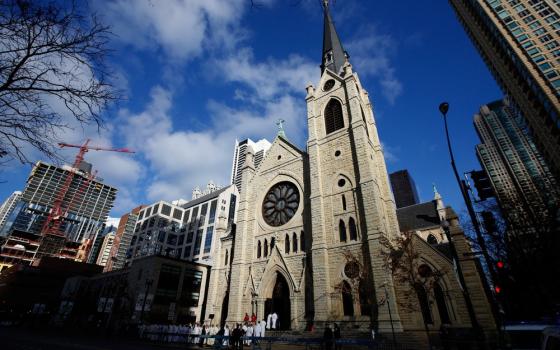
For decades, sociologists have tracked the trends of American Catholics in demographics, religious behavior and attitudes toward traditional values and church authority.
In 1997, James Davidson and colleagues identified three cohorts of Catholics -- pre-Vatican II, Vatican II and post-Vatican II -- each with its characteristic set of religious tendencies. Likewise, for 30 years William D'Antonio and his colleagues traced changes in attitudes and behavior among Roman Catholics. These studies have generated a relatively clear and consistent picture of U.S. Catholics. In general, they are becoming more autonomous, less observant of traditional practices and more like self-interested consumers of pastoral goods.
However, beneath the surface, what do these studies really mean? Or better, what does it feel like to live out of these categories in the concrete? Jerome Baggett, professor of religion and society at the Jesuit School of Theology in Berkeley, decided to try to find that out by interviewing almost 300 Catholic parishioners in six parishes in California's San Francisco-Oakland area. These six parishes provide a diversity of race, class and religious attitudes that mirrors remarkably well the church's national profile.
 For instance, one parish has become a haven for homosexual Catholics, another a base for the traditionalist right; several of these parishes are models of multicultural diversity, and two of them include significant upper-middle- class and upper-class parishioners.
For instance, one parish has become a haven for homosexual Catholics, another a base for the traditionalist right; several of these parishes are models of multicultural diversity, and two of them include significant upper-middle- class and upper-class parishioners.
Baggett chose to interview people who are strongly attached to these parishes, hoping to appreciate how these distinct communities understand and live their ways of being Catholic.
-----------------------------------------------------------------------------------------------------------
Read another review of this book: American Catholics, diverse and holy
-----------------------------------------------------------------------------------------------------------
While the national surveys referred to above suggest a picture of the church rent by painful disunity and polarization, Baggett's study, by contrast, provides sketches of parishes that develop meaningful, life-giving ministries for the people who find their spiritual home there. In part, this effect is explained by the voluntary choice of a congenial pastoral setting by people who are aware of the cultural and ideological variety available to them and who search for a place that fits their own idea of sacramental and community life.
This general picture is refined by Baggett's descriptions of "hometown parishes" where caring and emotional support are the attractive element, "multicultural parishes" that "cushion the pain" of being outsiders for those who are still finding their way in an unfamiliar culture, or "oppositional parishes" where a resistance to social wrongs provides the motivation for belonging. It is noteworthy that the two extreme examples of the gay church, on the one hand, and the traditionalist parish, on the other, are both "oppositional" from the perspective of sociological analysis -- the first opposing homophobia and the second irreverence.
Baggett hopes that the perspectives of those interviewed will stimulate further research into the actual pastoral scene and into the theological challenges of their ideas. He describes these respondents as "negotiating" their own proper place within the pastoral environment and selectively appropriating the religious culture that they find available to them. The faithful in these six parish settings seem to understand church membership as principally "therapeutic," seeking above all personal meaning and spiritual comfort for themselves without much awareness of their potential role as witnesses or evangelists of a Christian life that is symbolic of the kingdom of God.
Maybe the strongest single contribution of this book is Baggett's chapter about the conundrum of the stillbirth of Catholic social teaching in the U.S. church. He explains this in terms of "civic underachieving," shown by Catholics' above-average socioeconomic status but notorious low levels of giving and volunteering; in terms of "civic narrowing" through the inward focus of activities and moral concerns in parishes; and "civic silencing," illustrated by the clergy's reticence to alienate parishioners by speaking out on delicate, demanding or controversial social issues.
I have one regret about the author's approach. Nowhere does a discussion of age cohorts enter significantly into his analysis of social factors. His interview subjects are largely middle-aged and elderly, which does not diminish the cogency of the views they express, but does not say enough about the future of these communities.
Nevertheless, this careful, highly readable and fascinating book is a treasure for our moment of pastoral evolution. It presents and explains valuable sociological ideas that allow for the reframing of behaviors and attitudes in terms of cultural influences and social forces.
Baggett claims correctly, I believe, that the faithful today are different in how they practice their faith, but are not significantly less religious than their American Catholic ancestors. In his view, we are witnessing the end of an era of "devotional Catholicism" marked by nostalgia and authoritarianism, and the onset of a new era of lay initiative that will be marked by their critical appropriation of the Catholic tradition and a lively and creative autonomy.
Whether this prospect is correct or not, Baggett's thoughtful analysis of the lives of the faithful in six Catholic parishes representative of the national pastoral landscape provides depth and texture for reflecting on the U.S. pastoral scene that will interest any reader and critically inform the church's leadership.
Dominican Fr. Paul Philibert is a resident scholar at the Collegeville Institute at St. John's University in Minnesota.



